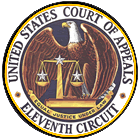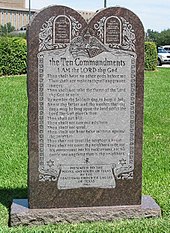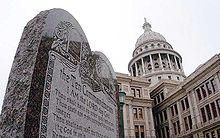Lemon v. Kurtzman, 403 U.S. 602 (1971), was a case argued before the Supreme Court of the United States. The court ruled in an 8–0 decision that Pennsylvania's Nonpublic Elementary and Secondary Education Act from 1968 was unconstitutional and in an 8–1 decision that Rhode Island's 1969 Salary Supplement Act was unconstitutional, violating the Establishment Clause of the First Amendment. The act allowed the Superintendent of Public Schools to reimburse private schools for the salaries of teachers who taught in these private elementary schools from public textbooks and with public instructional materials.
Wallace v. Jaffree, 472 U.S. 38 (1985), was a United States Supreme Court case deciding on the issue of silent school prayer.
Elk Grove Unified School District v. Newdow, 542 U.S. 1 (2004), was a case decided by the U.S. Supreme Court. The lawsuit, originally filed as Newdow v. United States Congress, Elk Grove Unified School District, et al. in 2000, led to a 2002 ruling by the United States Court of Appeals for the Ninth Circuit that the words "under God" in the Pledge of Allegiance are an endorsement of religion and therefore violate the Establishment Clause of the First Amendment to the United States Constitution. The words had been added by a 1954 act of Congress that changed the phrase "one nation indivisible" into "one nation under God, indivisible". After an initial decision striking the congressionally added "under God", the superseding opinion on denial of rehearing en banc was more limited, holding that compelled recitation of the language by school teachers to students was invalid.
In United States law, the Establishment Clause of the First Amendment to the United States Constitution, together with that Amendment's Free Exercise Clause, form the constitutional right of freedom of religion. The Establishment Clause and the Free Exercise Clause together read:
Congress shall make no law respecting an establishment of religion, or prohibiting the free exercise thereof...
McCreary County v. American Civil Liberties Union of Kentucky, 545 U.S. 844 (2005), was a case argued before the Supreme Court of the United States on March 2, 2005. At issue was whether the Court should continue to inquire into the purpose behind a religious display and whether evaluation of the government's claim of secular purpose for the religious displays may take evolution into account under an Establishment Clause of the First Amendment analysis.

Thomas David Van Orden was an American lawyer who unsuccessfully challenged the constitutionality of displaying the Ten Commandments on the grounds of the Texas Capitol under the Establishment Clause of the U.S. Constitution. Van Orden v. Perry, 125 S. Ct. 2854 (2005).

Glassroth v. Moore, 335 F.3d 1282, and its companion case Maddox and Howard v. Moore, 229 F. Supp. 2d 1290, is a decision from the United States Court of Appeals for the Eleventh Circuit that held a 2+1⁄2 ton granite monument of the Ten Commandments placed in the rotunda of the Heflin-Torbert Judicial Building in Montgomery, Alabama by then-Alabama Supreme Court Chief Justice Roy Moore was a violation of the Establishment Clause of the First Amendment.
County of Allegheny v. American Civil Liberties Union, 492 U.S. 573 (1989), was a United States Supreme Court case in which the Court considered the constitutionality of two recurring Christmas and Hanukkah holiday displays located on public property in downtown Pittsburgh. The first, a nativity scene (crèche), was placed on the grand staircase of the Allegheny County Courthouse. The second of the holiday display in question was an 18-foot (5.5 m) public Hanukkah menorah, which was placed just outside the City-County Building next to the city's 45-foot (14 m) decorated Christmas tree and a sign saluting liberty. The legality of the Christmas tree display was not considered in this case.
Stone v. Graham, 449 U.S. 39 (1980), was a court case in which the Supreme Court of the United States ruled that a Kentucky statute was unconstitutional and in violation of the Establishment Clause of the First Amendment, because it lacked a nonreligious, legislative purpose. The statute required the posting of a copy of the Ten Commandments on the wall of each public classroom in the state. The copies of the Ten Commandments were purchased with private funding, but the Court ruled that because they were being placed in public classrooms they were in violation of the First Amendment.
Lynch v. Donnelly, 465 U.S. 668 (1984), was a United States Supreme Court case challenging the legality of Christmas decorations on town property. All plaintiffs, including lead plaintiff Daniel Donnelly, were members of the Rhode Island chapter of the ACLU. The lead defendant was Dennis Lynch, then mayor of Pawtucket, Rhode Island.
Texas Monthly v. Bullock, 489 U.S. 1 (1989), was a case brought before the US Supreme Court in November 1988. The case was to test the legality of a Texas statute that exempted religious publications from paying state sales tax.
Pleasant Grove City v. Summum, 555 U.S. 460 (2009), is a decision from the Supreme Court of the United States which ruled on the U.S. Constitution's prohibition on a government establishment of religion specifically with respect to monuments on public land.
Capitol Square Review & Advisory Board v. Pinette, 515 U.S. 753 (1995), is a United States Supreme Court case that focused on First Amendment rights and the Establishment Clause. Vincent Pinette, an active member of the Ku Klux Klan in Columbus, Ohio, wanted to place an unattended cross on the lawn of the Capitol Square during the 1993 Christmas season. Pinette and his fellow members of the KKK submitted their request. The advisory board originally denied this request. However, Pinette and the other members of the Ohio Chapter of the Klan fought this decision in the United States District Court for the Southern District of Ohio. The court found in favor of the Klan and the advisory board issued the permit. The Board appealed to the United States Court of Appeals, which affirmed the decision of the district court. The board made one last petition to the Supreme Court where the decision was made, by a vote of seven to two, that the Klan was permitted to display the cross at the public forum.
Mueller v. Allen, 463 U.S. 388 (1983), was a United States Supreme Court case examining the constitutionality of a state tax deduction granted to taxpaying parents for school-related expenses, including expenses incurred from private secular and religious schools. The plaintiffs claimed that a Minnesota statute, allowing tax deductions for both public and private school expenses, had the effect of subsidizing religious instruction since parents who paid tuition to religious schools received a larger deduction than parents of public school students, who incurred no tuition expenses.
Walker v. Texas Division, Sons of Confederate Veterans, 576 U.S. 200 (2015), was a United States Supreme Court case in which the Court held that license plates are government speech and are consequently more easily regulated/subjected to content restrictions than private speech under the First Amendment.

Prescott v. Oklahoma Capitol Preservation Commission, 2015 OK 54, 373 P.3d 1032, was a landmark case by the Oklahoma Supreme Court in which the Court found the placement of a Ten Commandments Monument at the Oklahoma State Capitol was unconstitutional.
The Ten Commandments Monument, authorized by the Oklahoma legislature and approved by the governor in 2009, was installed on the grounds of the Oklahoma State Capitol, in Oklahoma City, in 2012. The mere concept engendered years of political controversy, court suits based on freedom of religion issues, destruction in 2014 by a man who drove his car into it, replacement in the same location, and even attempts to remove Supreme Court justices who ruled in 2014 that the monument must be removed to another site. After Governor Mary Fallin, key legislators, and the justices agreed on a substitute site, the monument was removed from the capitol grounds in 2015.
American Legion v. American Humanist Association, 588 U.S. ___ (2019), was a United States Supreme Court case dealing with the separation of church and state related to maintaining the Peace Cross, a World War I memorial shaped after a Latin cross, on government-owned land, though initially built in 1925 with private funds on private lands. The case was a consolidation of two petitions to the court, that of The American Legion who built the cross, and of the Maryland-National Capital Park and Planning Commission who own the land and maintain the memorial. Both petitions challenged the Fourth Circuit's ruling that, regardless of the secular purpose the cross was built for in honoring the deceased soldiers, the cross emboldened a religious symbol and had ordered it altered or razed. The Supreme Court reversed the Fourth Circuit's ruling in a 7–2 decision, determining that since the Cross had stood for decades without controversy, it did not violate the Establishment Clause and could remain standing.
Shurtleff v. City of Boston, 596 U.S. ___ (2022), was a United States Supreme Court case related to the First Amendment to the United States Constitution. The case concerned the City of Boston's program that allowed groups to have their flags flown outside Boston City Hall. In a unanimous 9–0 decision, the Court ruled that the city violated a Christian group's free speech rights when it denied their request to raise a Christian flag over City Hall.

Louisiana House Bill 71 is a law passed by the Louisiana State Legislature and signed by Governor Jeff Landry in 2024 that directs schools to display a copy of the Ten Commandments in classrooms.







